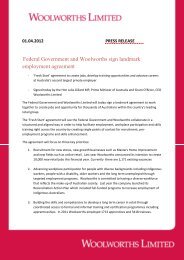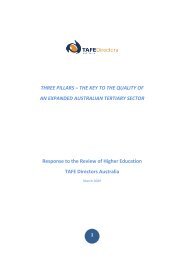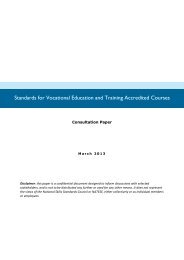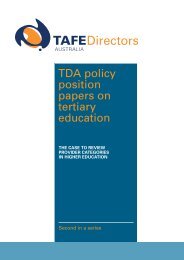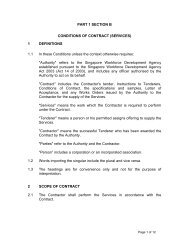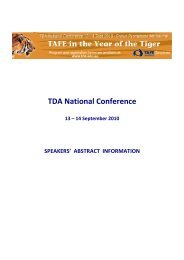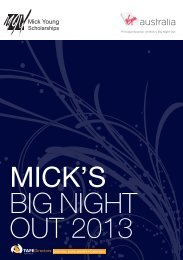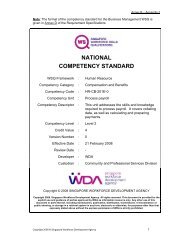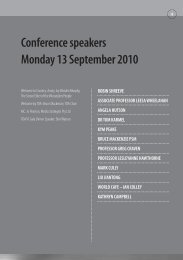here - TAFE Directors Australia
here - TAFE Directors Australia
here - TAFE Directors Australia
You also want an ePaper? Increase the reach of your titles
YUMPU automatically turns print PDFs into web optimized ePapers that Google loves.
2<br />
The Submission – TDA’s perspective and the context<br />
2.1 Purpose and aim<br />
On 27 November 2009, the Commonwealth Treasurer invited <strong>Australia</strong>n families, individuals, business<br />
and community groups to submit their ideas and priorities for the 2010–11 Budget. In doing so, the<br />
Treasurer referred to challenges facing the Nation arising from the global recession and the need to<br />
ensure <strong>Australia</strong> has a world-class education system.<br />
During 2009, the <strong>Australia</strong>n Government set out its vision for higher education and vocational<br />
education and training (VET) in several pronouncements, culminating in ‘Transforming <strong>Australia</strong>’s<br />
Higher Education System’, a policy statement published with the 2009–10 Budget papers. Responding<br />
to the Bradley Review of <strong>Australia</strong>n Higher Education, the statement announced a major investment<br />
by government in ‘<strong>Australia</strong>n universities and tertiary education system to drive comprehensive<br />
reform across the post-compulsory education and training sector’.<br />
This investment has meant that <strong>Australia</strong>n universities are set to benefit from substantially increased<br />
funding through demand-driven arrangements, incentive funding to enrol low SES students,<br />
performance related funding and better indexation.<br />
TDA and its member institutes across the country that deliver accredited higher education courses<br />
at degree level and above alongside the full range of nationally recognised vocational education<br />
and training programs, are dismayed that these reforms effectively exclude all non-university higher<br />
education providers (of which many are <strong>TAFE</strong> institutes) and the <strong>TAFE</strong> sector.<br />
These reforms, while welcomed by universities and the community generally, stand in extraordinary<br />
contrast to the resourcing crisis facing <strong>Australia</strong>’s <strong>TAFE</strong> institutes.<br />
TDA believes a parallel set of reforms for the national <strong>TAFE</strong> system is sorely needed. The 2010–11<br />
Commonwealth Budget can provide the vehicle for achieving this objective, complementing the<br />
university reforms and representing the next step in achieving the goal of delivering for <strong>Australia</strong>, a<br />
world-class education system that includes dramatically higher SES participation and achievement rates.<br />
The TDA strategy for the 2010–11 Commonwealth Budget relies on leveraging the nearly 30 years of<br />
federal, state and territory government investment in our public <strong>TAFE</strong> institutes and, with dedicated<br />
purpose funding commitments, enables <strong>TAFE</strong> institutes – still the most trusted brand for skills delivery<br />
by households and business – to have an enhanced role and one which equips them to partner with<br />
our universities in transforming <strong>Australia</strong>’s post-compulsory education and training system.<br />
4





